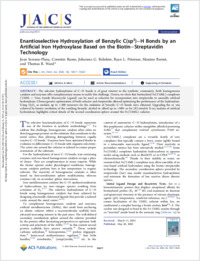Enantioselective Hydroxylation of Benzylic C(sp3)-H Bonds by an Artificial Iron Hydroxylase Based on the Biotin-Streptavidin Technology.
- Serrano-Plana J Department of Chemistry, University of Basel, BPR1096, Mattenstrasse 24a, CH-4058 Basel, Switzerland.
- Rumo C Department of Chemistry, University of Basel, BPR1096, Mattenstrasse 24a, CH-4058 Basel, Switzerland.
- Rebelein JG Department of Chemistry, University of Basel, BPR1096, Mattenstrasse 24a, CH-4058 Basel, Switzerland.
- Peterson RL Department of Chemistry, University of Basel, BPR1096, Mattenstrasse 24a, CH-4058 Basel, Switzerland.
- Barnet M Department of Chemistry, University of Basel, BPR1096, Mattenstrasse 24a, CH-4058 Basel, Switzerland.
- Ward TR Department of Chemistry, University of Basel, BPR1096, Mattenstrasse 24a, CH-4058 Basel, Switzerland.
- 2020-05-27
Published in:
- Journal of the American Chemical Society. - 2020
English
The selective hydroxylation of C-H bonds is of great interest to the synthetic community. Both homogeneous catalysts and enzymes offer complementary means to tackle this challenge. Herein, we show that biotinylated Fe(TAML)-complexes (TAML = Tetra Amido Macrocyclic Ligand) can be used as cofactors for incorporation into streptavidin to assemble artificial hydroxylases. Chemo-genetic optimization of both cofactor and streptavidin allowed optimizing the performance of the hydroxylase. Using H2O2 as oxidant, up to ∼300 turnovers for the oxidation of benzylic C-H bonds were obtained. Upgrading the ee was achieved by kinetic resolution of the resulting benzylic alcohol to afford up to >98% ee for (R)-tetralol. X-ray analysis of artificial hydroxylases highlights critical details of the second coordination sphere around the Fe(TAML) cofactor.
- Language
-
- English
- Open access status
- hybrid
- Identifiers
-
- DOI 10.1021/jacs.0c02788
- PMID 32450689
- Persistent URL
- https://folia.unifr.ch/global/documents/114683
Statistics
Document views: 13
File downloads:
- fulltext.pdf: 0
